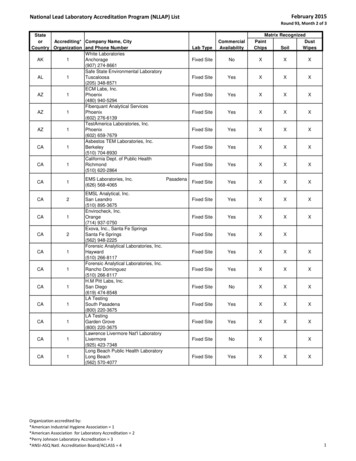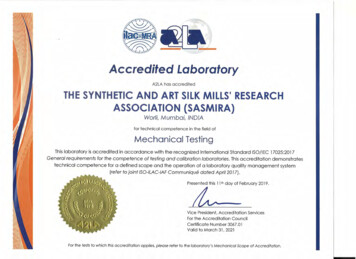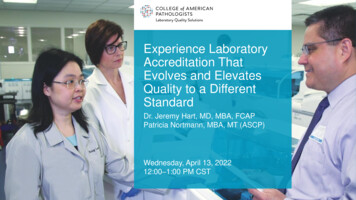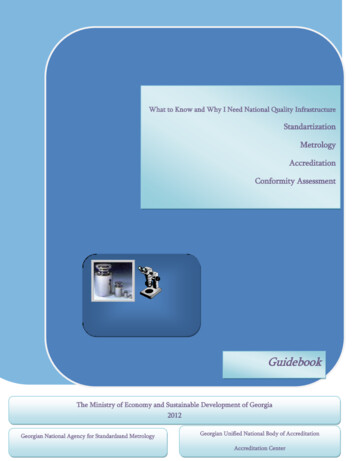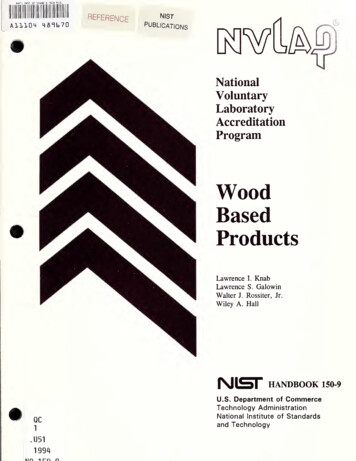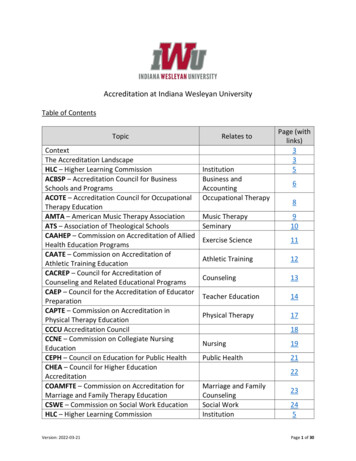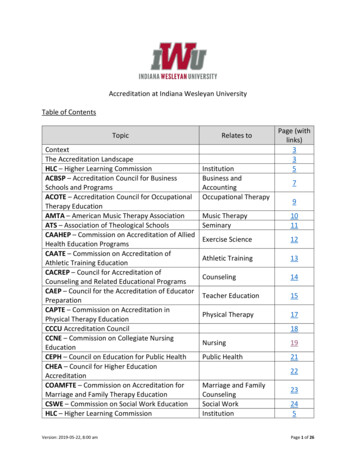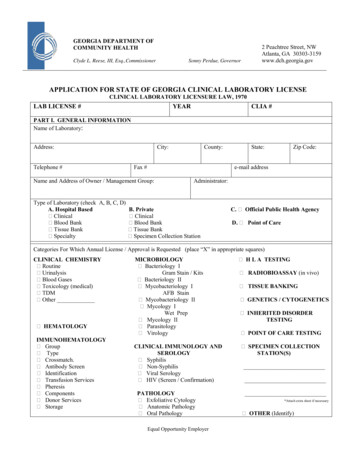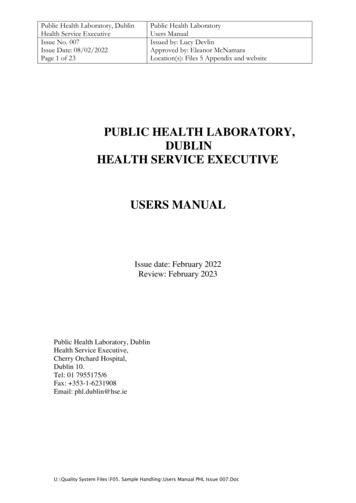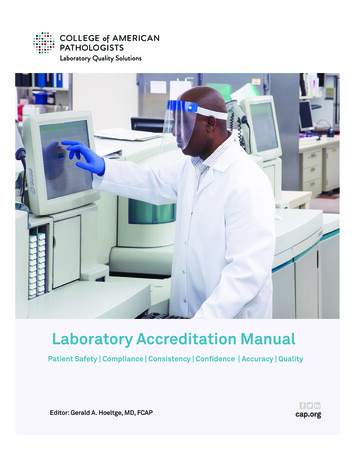
Transcription
Laboratory Accreditation ManualPatient Safety Compliance Consistency Confidence Accuracy QualityEditor: Gerald A. Hoeltge, MD, FCAPcap.org
How to Contact the CAPThe information below identifies laboratory accreditation resources at the College ofAmerican Pathologists. Please contact the appropriate person by phone, mail, or fax. By phone:The CAP’s main telephone number is 800-323-4040 or 847-832-7000.CAP Accrediation business hours are 8:00 AM–5:00 PM Central Time, Mondaythrough Friday, excluding holidays. By mail:Mail accreditation materials to:CAP Accreditation ProgramsCollege of American Pathologists325 Waukegan RoadNorthfield, IL 60093 By fax:The Accreditation Program’s main fax number is 847-832-8171. By email: Contact the College of American Pathologists at cap.org.Call CAP at 800-323-4040 or 847-832-7000 for questions about Accreditation program brochures Application/reapplication Director changes Inspector assignments Inspection dates Inspection materials or packets Laboratory demographic changes Laboratory test menu New laboratories Ownership changes Self-evaluation Status of accreditationCall CAP Accreditation Technical Specialists at 800-323-4040 or 847-832-7000 ext.6065 or email to accred@cap.org for questions about Interpretation of checklist items Responding to deficiencies Technical review of deficienciesCall the Investigations Analyst at 866-236-7212 or 847-832-7533 for informationabout CMS validation inspections Complaints about laboratoriesCall the Regulatory Affairs Analyst at 800-323-4040 ext. 7492 or 847-832-7492 forinformation about CMS reporting issues State reporting issuesContinued on inside back cover
TABLE OF CONTENTSTOPICPAGEIntroduction2Accreditation Program Types6Commission Philosophies9Applying to CAP Accreditation Programs13Other Types of Laboratories and Inspection Options18Preparing for the Inspection: Laboratory23Preparing for the Inspection: Inspection Team27Proficiency Testing: Enrollment and Handling36Proficiency Testing: Failures and Monitoring39Accreditation Checklists43Conducting the Inspection: General Principles and Meetings48After the Inspection: Inspection Team63After the Inspection: Laboratory65Maintaining Accreditation71Non-Routine Inspections76Complaints and Investigations77International Laboratory Accreditation79Appendices83Appendix A: Accreditation Checklist Usage SummaryAppendix B: Instructions for Determining Test VolumeAppendix C: Retention of Laboratory Records and MaterialsAppendix D: Glossary of TermsAppendix E: CAP Accreditation Tools and Resources83899194108College of American PathologistsLaboratory Accreditation Manual 2018 Edition1
INTRODUCTIONTOPICPAGEPurpose of this Manual2Overview of Accreditation Programs2Accreditation Program Organization3Commissioners3Inspectors and CAP Staff4Accreditation Documents4Standards for CAP Accreditation Programs4Accreditation Checklists5Purpose of this ManualThe Laboratory Accreditation Manual is intended to provide laboratories and inspectors a basicoverview on the CAP’s accreditation programs and accreditation processes.Overview of Accreditation ProgramsThe College of American Pathologists (CAP) directs multiple accreditation programs. Adescription of each of these programs is included in the Accreditation Program Types section.The accreditation programs were created with the primary objective of improving the quality ofclinical laboratory services through voluntary participation, professional peer review, education,and compliance with established performance standards. Since their creation, these programshave become widely acknowledged for excellence. In total, the CAP accredits more than 8,000laboratories in 53 countries.The accreditation programs are based on rigorous accreditation standards that are translatedinto detailed checklist requirements. CAP inspection teams use the checklists as a guide toassess the laboratory's overall management and operation. Inspectors examine preanalytic,analytic, and postanalytic aspects of quality management (QM) in the laboratory. These includethe performance and monitoring of general quality control (QC); test methodologies andspecifications; reagents, controls, and media; equipment; specimen handling, test reporting andinternal performance assessment; and external proficiency testing. In addition, personnelrequirements, safety, document management, and other administrative practices are included inthe inspection process.The programs are internationally recognized and are the only ones that utilize teams ofpracticing laboratory professionals as inspectors. Designed to go well beyond regulatorycompliance, the program helps laboratories achieve the highest standards of excellence andpositively impact patient care.College of American PathologistsLaboratory Accreditation Manual 2018 Edition2
Accreditation Program OrganizationThe Council on Accreditation (CoA) sets the strategic direction for the CAP’s accreditationprograms, in accordance with the CAP’s vision, and monitors its overall effectiveness inensuring that participating laboratories meet regulatory and CAP requirements. The CoA alsoprovides oversight to the Commission on Laboratory Accreditation (CLA), a group of qualifiedpathologists appointed with the following charges: Advance the CAP’s accreditation programs as the prime exemplar for the inspection andaccreditation of clinical laboratories and biorepositoriesAdminister the programs through the principles of peer review and educationFurther the goal of laboratory improvement in order that quality laboratory services areprovided to patients and clientsEnsure that the programs continue to meet the scientific, service, and regulatory needsof participantsEnhance the recognition of the pathologist laboratory director’s role in clinical decisionmaking and consultation.The CLA oversees and coordinates the activities of five CLA committees in the development,maintenance, and implementation of accreditation checklists and standards, the inspectionprocesses, inter-inspection assessment tools, complaint investigations, and program education.The CLA also ensures that committee priorities and activities are aligned with the overall goalsand strategies supporting the CAP’s Accreditation programs. The CLA uses the expertise ofnumerous CAP scientific resource committees to keep the programs and their requirementsabreast of new developments in laboratory medicine.The Accreditation Committee, another arm of the CoA, is responsible for ensuring objectivityand consistency in CAP accreditation decisions. The Accreditation Committee is responsible forall accreditation status decisions, including accreditation suspension and probation, based onthe recommendations from the reviewing commissioners, technical specialists, and other LAPcommittees.CommissionersRegional commissioners are responsible for the accreditation activities of a specified group oflaboratories. This includes the timely assignment of inspectors, review of inspection findings,and presentation of accreditation issues to the Accreditation Committee. Following an on-siteinspection, the regional commissioner, in conjunction with CAP technical staff, reviews theinspection findings and the laboratory’s corrective action, and contributes to any follow-upnecessary to reach an accreditation decision.State and division commissioners assist the regional commissioners. State and divisioncommissioners are responsible for validating proposed inspector matches for the laboratories intheir geographic regions. They are assisted by CAP staff to ensure that inspections are timelyand in accordance with accreditation program policy. They are responsible for providingfeedback and mentoring to volunteer inspectors.College of American PathologistsLaboratory Accreditation Manual 2018 Edition3
Inspectors and CAP StaffThe inspectors who conduct the on-site laboratory inspections are the lifeblood of theaccreditation programs. Typically, the inspection team leader is a board-certified pathologistwho has received training and has participated in several inspections as a team member.Inspection team members are other pathologists, doctoral scientists, supervisory-level medicaltechnologists, pathology residents and fellows, and other individuals who have been trained inCAP inspection requirements and have expertise in the area of the laboratory that they inspect.The CAP accreditation program staff at the CAP headquarters in Northfield, Illinois, comprisestechnical and administrative personnel who carry out the policies and procedures of the CLAand who are responsible for the management and operation of the program. They also include alimited number of full-time inspectors who conduct inspections meeting defined criteria.Accreditation DocumentsIn addition to this manual, three other documents are fundamental to the inspection process: 1)the Standards for Laboratory Accreditation (the Standards), 2) the Accreditation Checklists, and3) the Inspector’s Summation Report (ISR). Through peer review, the inspector uses thechecklists to determine if the laboratory meets the criteria set out in the Standards. Theinspector collects information and records it on the ISR; this information is the basis for theregional commissioner’s accreditation recommendation. In addition to verifying compliance withaccreditation requirements, the inspection team may share ideas for laboratory improvement.Inspection team members often take new ideas or processes back to their own laboratories.Standards for CAP Accreditation ProgramsThe Standards constitute the core principles of the CAP’s accreditation programs. The objectiveof the Standards is to ensure that accredited laboratories meet the needs of patients,physicians, and other health care practitioners. The CAP accredits laboratories that conform tothe Standards. Each of the four accreditation programs has its own Standards for Accreditation.The CAP Board of Governors approves these standards, which have evolved through years ofstudy and continuous review by the CLA and CoA. The inspector must be familiar with eachstandard and its interpretation. A copy of the Standards is included with each inspection packet,and must be reviewed before the inspection of the laboratory. The inspection team leader isconsidered the on-site authority for the interpretation of these standards.Standard I relates to the qualifications, responsibilities, and role of the director. It discusseswhich responsibilities may be delegated, as well as the role of a consulting pathologist.Standard II concerns the physical resources of the laboratory, including space andinstrumentation; furnishings; communication and data processing systems; reagents and othersupplies; ventilation; piped gases and water; public utilities; storage and waste disposal; andprotection of patients, laboratory personnel, and visitors from hazardous conditions.Standard III encompasses quality management. This includes discussions of test systemvalidations, QC of preanalytic, analytic and postanalytic processes, proficiency testing (orperiodic alternative assessments of laboratory test performance), and ongoing performanceimprovement.College of American PathologistsLaboratory Accreditation Manual 2018 Edition4
Standard IV includes the administrative requirements of the program. Laboratories mustcomply with the requirements specified in the Standards, the terms of accreditation, and theaccreditation checklists. On-site inspection by an external team and an interim self-inspectionare the cornerstones of the inspection requirement. Participating laboratories also provide aninspection team when requested.Accreditation ChecklistsEach checklist is a detailed list of requirements that the inspector uses to determine if thelaboratory meets the Standards. Each requirement is uniquely numbered and centers on adeclarative statement. The checklists serve as instruments to guide the conduct of theinspection. The checklists are revised periodically and include approximately 2,900requirements. Detailed information on the checklists is included in the Accreditation Checklistssection and in Appendix A: Accreditation Checklist Usage Summary.College of American PathologistsLaboratory Accreditation Manual 2018 Edition5
ACCREDITATION PROGRAM TYPESTOPICPAGELaboratory Accreditation Program6Reproductive Laboratory Accreditation Program7Forensic Drug Testing Program7Biorepository Accreditation Program8CAP 15189 Accreditation Program8The CAP’s Accreditation Programs cover the entire spectrum of laboratory disciplines using themost scientifically rigorous checklist requirements. There are five unique programs tailored tothe needs of specific types of laboratories.The CAP’s accreditation programs offer: Help towards continuous complianceConfidence in the accuracy of clinical reportsImproved risk managementAccess to best practicesThe right to display the CAP Accreditation MarkFacilities that choose any of the CAP accreditation programs also receive access to a range ofeducational opportunities, proven products and services, and health care professionals that helplaboratories to excel.Laboratory Accreditation ProgramThe Laboratory Accreditation Program (LAP) was established in 1961, and the range oflaboratory disciplines includes: Anatomic PathologyChemistry and ToxicologyClinical Biochemical GeneticsCytogeneticsCytopathologyFlow robiologyMolecular PathologyPoint-of Care TestingTransfusion MedicineUrinalysisCollege of American PathologistsLaboratory Accreditation Manual 2018 Edition6
The LAP accredits a wide variety of laboratories in different settings, such as communityhospitals, university-based hospitals, out-patient clinics, and reference laboratories. Theprogram uses a two-year accreditation cycle where laboratories have an on-site inspectionevery two years by an inspection team made up of practicing professionals.The LAP is a CMS-approved accrediting organization for clinical laboratories under the ClinicalLaboratory Improvement Amendments of 1988 (CLIA 88) and is also recognized by the JointCommission. In addition, the LAP is accepted by the United Network for Organ Sharing and theNational Marrow Donor Program for histocompatibility testing.Laboratories that are part of a healthcare system with highly integrated laboratory services maybe eligible for the System Inspection option. Refer to section Applying for Accreditation for moreinformation on this option.Reproductive Laboratory Accreditation ProgramThe CAP developed the Reproductive Laboratory Accreditation Program (RLAP) in 1993 incollaboration with the American Society of Reproductive Medicine (ASRM) to meet the uniqueneeds of reproductive laboratories. The services covered in the RLAP include: AndrologyLimited clinical laboratory testing (eg, hormone assays, hematology, urinalysis)EmbryologyCryopreservationReproductive tissue storageLaboratories in the RLAP have an on-site inspection every two years by an inspection teammade up of practicing professionals. They are inspected with the Reproductive LaboratoryMedicine, Laboratory General, Director Assessment, and All Common Checklists, as well asadditional discipline-specific checklists if additional clinical testing is performed.The RLAP is a CMS-approved accrediting organization for andrology and other tests regulatedby CLIA 88 and is also recognized by The Joint Commission, In addition, the Society ofAssisted Reproductive Technology (SART) recognizes RLAP accreditation of embryologylaboratories for SART membership.Forensic Drug Testing ProgramThe CAP Forensic Drug Testing Accreditation Program (FDT) was established in 1988 and isavailable for laboratories performing confirmatory drug testing on urine, oral fluid, hair, andblood for nonmedical purposes, such as workplace drug testing. The program also acceptslaboratories that perform urine screen-only testing by nonwaived methods.Laboratories in FDT have an on-site inspection every two years by an inspection team made upof practicing professionals. They are inspected with the Forensic Drug Testing, LaboratoryGeneral, Director Assessment, and All Common Checklists.College of American PathologistsLaboratory Accreditation Manual 2018 Edition7
Biorepository Accreditation ProgramThe CAP’s Biorepository Accreditation Program (BAP) is the newest program introduced in2011 and is designed to improve the quality and consistency of facilities that collect, process,store, and distribute biospecimens for research.Services covered include biorepository specimen collection/procurement, specimen distributionand agreements, specimen informatics, specimen processing, and specimen storage.Facilities in the BAP have an on-site inspection every three years by an inspection team madeup of practicing professionals. They are inspected with Biorepository and General Checklists.CAP 15189 Accreditation ProgramThe CAP 15189 Accreditation Program was created in 2008 to assist laboratories in maintainingcompliance with all ISO 15189 requirements. Laboratories must first be accredited through theCAP’s Laboratory Accreditation Program to qualify to the CAP 15189 program. This programcomplements the LAP by optimizing processes to improve patient care, strengthen deploymentof quality standards, mitigate risk, and control costs.Laboratories in the CAP 15189 program have an on-site assessment every three years byexperienced assessors that have practical knowledge of medical laboratory testing and ISOquality management systems auditing. The program also provides readiness and advisoryservices and online education courses on quality management systems.Information on the CAP 15189 program is available on www.cap.org under LaboratoryImprovement, Accreditation, CAP 15189 Accreditation Program.College of American PathologistsLaboratory Accreditation Manual 2018 Edition8
COMMISSION PHILOSOPHIESTOPICPagePeer 10Solicitation10Confidentiality11Confidentiality – HIPAA Privacy Rule and HITECH Act11Inspector Liability11Conflict of Interest12Peer ReviewPurpose: To improve laboratory performance through objective evaluation and constructivecriticism.The inspector can enhance the spirit of peer review and the educational benefit of the inspectionprocess by adhering to the following: As representatives of the accreditation program and the CAP, inspectors must strive to beobjective and fair. There is often more than one way to comply with a requirement. The inspection team leader should be a peer of the laboratory director. Deficiencies should be presented factually. Provide recommendations for improvement ifpossible. A negative, unduly critical, or punitive attitude should be avoided. Deficiencies cited by the inspection team may be challenged. If resolution of a disagreementbetween laboratory personnel and an inspector cannot be achieved before or during thesummation conference, the laboratory may challenge the deficiency during the postinspection process. For more information, refer to the section Post-inspection for theLaboratory - Challenging a Deficiency in this manual.ThoroughnessThe CAP inspection process is approved by the Centers for Medicare and Medicaid Services(CMS) and must meet all federal regulatory requirements. Additionally, participating laboratoriesexpect a thorough, detailed, and fair inspection. All pertinent items in the customized checklistmust be inspected. Since laboratories must be inspection-ready at all times, as part of providingCollege of American PathologistsLaboratory Accreditation Manual 2018 Edition9
quality patient care, they appreciate validation of the work they do and deserve acomprehensive inspection. A deficiency should not be overlooked because it seems minor.JudgmentThe Commission relies upon the inspector’s judgment more than any other attribute in theassessment of a laboratory. This attribute is, however, the most difficult to standardize. Therewill be occasions when a conscientious inspector will have difficulty deciding whether alaboratory is in compliance with a checklist requirement. Many of these decisions involveassessment of partial compliance with the checklist requirement. Therefore, the inspector mustdescribe the observations as completely as possible in the Inspector’s Summation Report. Thisdescription should include details of the sampling that was performed to assess compliance withthe requirement. For example, a description may include, “In the review of xx number of recordsfor a specific expected result, the laboratory was found to be out-of-compliance with yy records.”With this detailed information, the CAP can better assess the corrective action that thelaboratory proposes.DisputesTo help resolve questionable citations, the inspector and/or laboratory personnel may contactthe CAP’S accreditation technical staff by telephone during the inspection (800-323-4040 ext6065). Following the inspection, if a laboratory wishes to challenge a particular citation, it muststate its disagreement in the deficiency response and provide documentation to demonstratehow it was in compliance before it was inspected. The regional commissioner will reviewdisputed items and determine if the deficiency can be removed from the inspection record.HarassmentEmployees of laboratories inspected by the CAP are entitled to a workplace environment that isfree from sexual or other unlawful harassment. Prohibited harassment includes any comments,gestures, innuendos, or physical contact that create an intimidating, offensive, or hostileenvironment. Also prohibited are behaviors that harass an employee based on race, gender,disability, age, religion, national origin, or other legally protected category.Inspectors on a CAP team, whether the team leader or a team member, must never displayconduct that can reasonably be construed as harassment. Team leaders must ensure that thebehavior of team members is consistent with this position; they must intervene actively ifinappropriate conduct is observed.Employees of laboratories should report inappropriate conduct on the part of CAP team leadersor team members to CAP headquarters. The CAP does not tolerate harassment. In cases ofdocumented harassment, the CAP will take appropriate action.SolicitationInspectors must not in any way solicit the institution, the laboratory, or its employees for anypurpose. They must never display conduct that can be reasonably construed as a solicitation.Inspectors should not request any information from the institution or laboratory regarding fees orother business-related matters. The inspector should not request any information regarding theCollege of American PathologistsLaboratory Accreditation Manual 2018 Edition10
director’s contractual relationship with the institution’s administration. However, when thelaboratory director is present less than full time, it is appropriate to ask about contractualagreements indirectly to ensure that the needs of the institution are met.ConfidentialityAll inspection findings are confidential. They should not be discussed in any context other thanthe inspection itself. Moreover, they should not be disclosed to anyone not associated with theaccreditation process unless appropriate prior documented consent has been obtained.Confidentiality – HIPAA Privacy Rule and HITECH ActUnder the Health Insurance Portability and Accountability Act of 1996 (HIPAA), the CAP isconsidered a “business associate” of any CAP-accredited laboratory that is designated a“covered entity” under HIPAA. The CAP is required, therefore, to enter into a BusinessAssociate Agreement (BAA) with such a laboratory to protect the privacy and security of patienthealth information. The CAP has developed a standardized model BAA for its accreditedlaboratories to meet HIPAA, the privacy and security regulations promulgated thereunder, andSubtitle D of the Health Information Technology for Economic and Clinical Health Act of 2009(HITECH). The model BAA may be found on www.cap.org by logging into the CAP e-LABSolutions Suite and clicking on the “CAP Accreditation Resources” link.The CAP further protects the CAP-accredited laboratory by requiring all CAP inspectors to atteston the inspection report that they will keep any patient information confidential and use it onlyfor purposes of the CAP inspection. Other CAP personnel or agents who may have access toprotected health information are trained concerning their obligation to keep this informationconfidential and to use such information only within the context of the inspection andaccreditation services provided to the laboratory. In addition, the CAP requires that laboratoriessubmit only documentation and other materials to the CAP that have been de-identified of allprotected health information (PHI), as that term is defined in 45 C.F.R. Parts 160 and 164, inaccordance with HIPAA and its implementing regulations (see 45 C.F.R. § 164.514(b)) unlessthe laboratory must submit PHI to the CAP in order to respond to a deficiency or complaintinvestigation.Inspector LiabilityThe CAP bylaws include a provision that indemnifies volunteers, including inspectors, againstliability and expenses, including attorney fees, incurred in connection with any legal action inwhich the individual is made a defendant by reason of the individual's good faith efforts onbehalf of the CAP. Inspectors approached in this regard by a laboratory, patient, or an attorneyregarding inspection activities should contact the CAP immediately to invoke this provision.Inspectors may not discuss any inspection findings with anyone outside the inspected laboratoryor the CAP.College of American PathologistsLaboratory Accreditation Manual 2018 Edition11
Conflict of InterestAccreditation must be carried out in an impartial and objective manner, uninfluenced by anypersonal, financial, or professional interest of any individual acting on behalf of the CAP.Inspectors must not be engaged in close personal, family, business, or professionalrelationships with any personnel in a laboratory that they inspect. An inspector must not solicitor accept gifts of any type, including personal gifts, products, services, or entertainment. Neithershall inspectors discuss, solicit, accept, or have an employment or consulting arrangement,referral of business, or other business opportunity with the laboratory that they inspect.The inspection team does not make the accreditation decision, and the subject laboratory maychallenge any deficiency citation. Further, the CLA believes that team leaders and inspectorswill conduct inspections objectively and professionally, regardless of whether they are incompetition with the subject institution. Prior to unannounced inspections, the CAP requiresteam leaders to sign a statement attesting to the absence of conflict of interest.The laboratory is notified in advance of the team leader’s name and institution. However, thelaboratory should not contact the inspector, even if a conflict of interest should be apparent.Instead, prior to the inspection, the laboratory may discuss the specifics of a perceived conflictof interest with CAP staff or the state and/or regional commissioner, or complete and return theconflict of interest form that is found in the self-inspection materials. CAP headquarters willevaluate and discuss this information with the state or regional commissioners for finaldetermination. All state or regional commissioners have discretion to recommend reassignmentif there appears to be a valid conflict of interest. A laboratory may notify CAP headquarters ofperceived conflicts when the inspection assignment is made. However, the CAP may determineat any time that the perceived conflict of interest is not valid and the laboratory may not bereassigned to a new inspection team. The laboratory should not contact the assigned inspector.College of American PathologistsLaboratory Accreditation Manual 2018 Edition12
APPLYING TO CAP ACCREDITATION PROGRAMSTOPICPageApplication Request Form13Proficiency Testing (PT) Prerequisite13Application Forms and Supplemental Materials – New Laboratories14Biorepository Accreditation Program15Laboratory Disciplines15Activity Menu16Reapplication Process16AABB Coordinated Inspection16Submitting the Application/Reapplication17Application Request FormLaboratories seeking accreditation by the CAP must submit an Application Request form alongwith a nonrefundable application fee. Once the application request is processed, theaccreditation application, master checklists, and many more resources are available online viaeLAB Solutions Suite . Paper application materials will also be sent but the CAP encourageslaboratories to use the online application/reapplication system.A new applicant to the accreditation program has up to six months to complete and return theapplication materials. The application materials for the Biorepository Accreditation Program arenot yet available through e-LAB Solutions Suite .Laboratories with separate CLIA numbers seeking CAP accreditation must be accreditedseparately, even if operating within the same institution. Laboratories under separate CLIAnumbers seeking CAP accreditation at the same address must have separate CAP numbers,and likewise must enroll in separate PT products. Laboratories operating under separate CLIAcertificates must submit separate fees and application request forms. If a laboratory chooses tohave its inspections coordinated with an existing CAP-accredited laboratory, this informationmust be provided in the application.Proficiency Testing (PT) Prerequisite Each separately accredited laboratory must periodically assess the accuracy of eachpatient-reportable test that is performed under its own CAP number.For analytes that require external proficiency testing (PT), each laboratory must enroll andparticipa
The information below identifies laboratory accreditation resources at the College of American Pathologists. Please contact the appropriate person by phone, mail, or fax. . College of American Pathologists Laboratory Accredita tion Manual 2018 Edition 7 The LAP accredits a wide variety of laboratories in different settings, such as community
